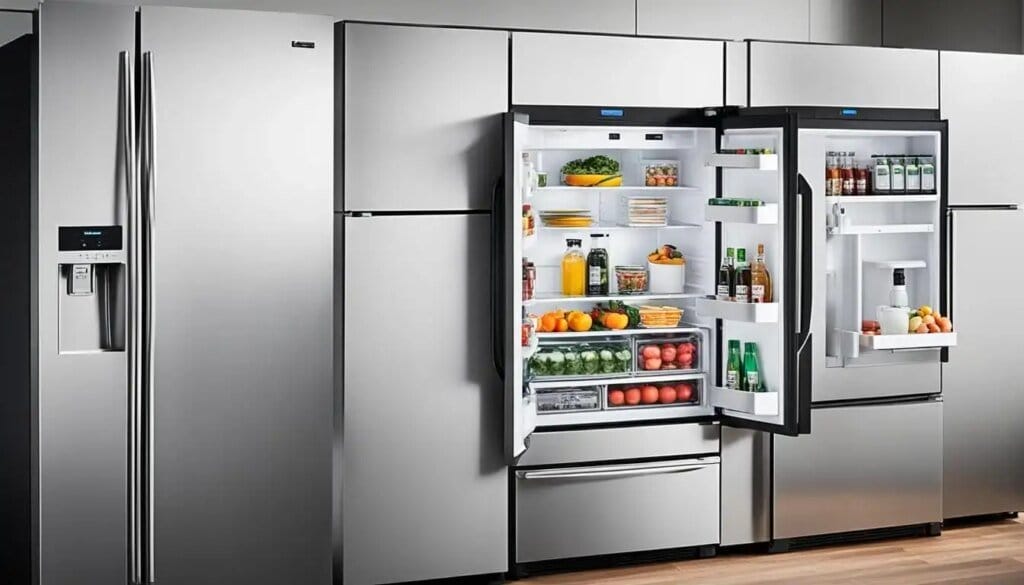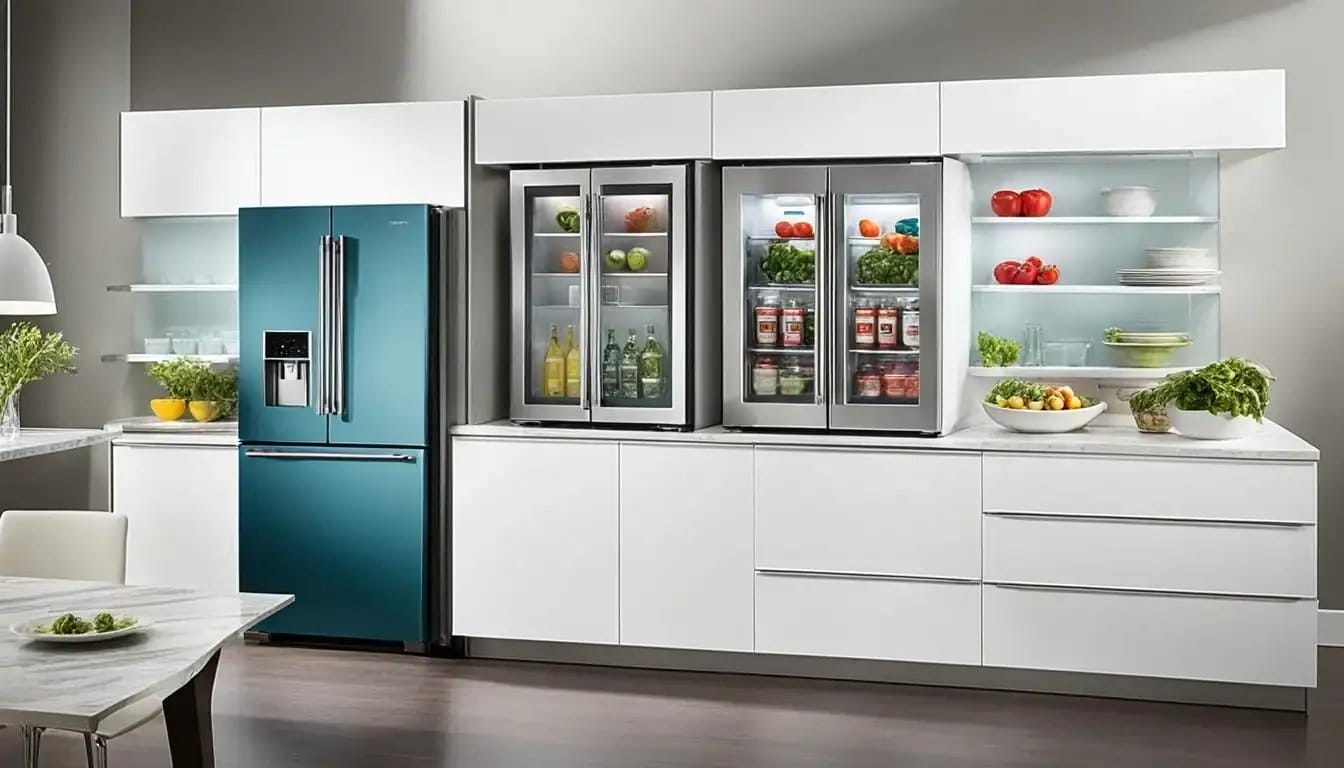When it comes to choosing a refrigerator, this decision can have a significant impact on your kitchen’s style, functionality, and budget. The choice between a built-in and countertop fridge is one that many homeowners face. Understanding the differences between these two options is crucial to making the right decision for your kitchen.
In this post, I will explore the key factors you need to consider when choosing between a built-in and countertop fridge. We’ll discuss kitchen integration, aesthetic appeal, pros and cons, costs, installation, and spatial dynamics.
So, let’s explore the world of built-in and countertop fridges!
Key Takeaways:
- Choosing between a built-in and countertop fridge is an important decision that can impact your kitchen’s style, functionality, and budget.
- Understanding the differences between built-in and countertop fridges will help you make an informed decision.
- Key factors to consider include kitchen integration, aesthetic appeal, practical pros and cons, costs, installation, and spatial dynamics.
- Assessing your needs and consulting with a kitchen design professional can guide you in choosing the right fridge for your kitchen.
- Stay tuned as we explore the differences between built-in and countertop fridges in detail!
The Basics: Built-In And Countertop Fridges
These two options offer distinct features and visual impact. In this section, I will define built-in refrigerators, explain countertop depth fridges, and help you visualize how they integrate into your kitchen design.
1. Built-In Refrigerators
Built-in refrigerators are specifically designed to be housed within cabinetry or custom-built surroundings. They offer a seamless integration that enhances the overall aesthetic appeal of your kitchen.
With built-in options, you have the choice between overlay built-in refrigerators and integrated built-in refrigerators.
- Overlay built-in refrigerators feature custom panels on the exterior that can match the surrounding cabinetry. This design helps to create a uniform and integrated look in your kitchen, making the refrigerator blend in seamlessly with the rest of your cabinetry.
- Integrated built-in refrigerators go a step further. These models are completely flush with the cabinet doors, giving your kitchen a sleek and modern appearance. The integrated design eliminates any visible gaps or seams, achieving a high level of kitchen integration.
2. Countertop (Counter-Depth) Fridges
- Countertop refrigerators, also known as counter-depth fridges, are freestanding units with a body that matches the depth of your kitchen counter. However, they have doors that protrude past the counter, creating a visual impact in your kitchen.
- While counter-depth refrigerators may not offer the same level of seamless integration as built-in models, they provide a unique aesthetic appeal.
- These freestanding units can add a touch of modernity and style to your kitchen design, becoming a focal point in your kitchen.
3. The Differences In Kitchen Integration
To better understand the distinctions between built-in and countertop depth refrigerators, it helps to visualize their integration in your kitchen.
Whether you prefer the sleek, integrated look of a built-in refrigerator or the visually impactful presence of a countertop fridge, considering the visual impact is crucial in making the right choice for your kitchen.

The Aesthetic Appeal: Built-In vs Countertop Fridge
When it comes to choosing a refrigerator for your kitchen, the aesthetic appeal plays a crucial role. The seamless integration with cabinetry and the visual impact of freestanding refrigerators are important factors to consider.
1. Seamless Integration With Cabinetry
One of the standout features of built-in refrigerators is their seamless integration with cabinetry.
- These refrigerators are designed to blend perfectly with your kitchen’s cabinetry, creating a cohesive and streamlined look.
- Overlay built-in refrigerators come with custom panels that can match your surrounding cabinets. This allows you to achieve a uniform and integrated appearance in your kitchen.
- Integrated built-in refrigerators are completely flush with the cabinet doors, further enhancing the seamless integration.
2. Visual Impact Of Freestanding Refrigerators
If you prefer a more visually striking option, freestanding refrigerators, such as countertop refrigerators, can create a unique visual impact in your kitchen. These freestanding appliances stand out and become a focal point, adding a touch of personality to your kitchen design.
Whether you choose the seamless integration of built-in refrigerators or the visual impact of freestanding refrigerators, it’s essential to consider your personal style and desired kitchen aesthetic.
Pros & Cons Of Each Appliance
Understanding the pros and cons of built-in and countertop depth refrigerators can help you weigh your options. Let’s take a closer look at the advantages and disadvantages of each:
1. Built-in Refrigerators
- Pros:
- High-end look: Built-in refrigerators offer a sleek and luxurious appearance, enhancing the overall aesthetic of your kitchen.
- Increased value: These refrigerators can increase the resale value of your home, making them a worthwhile investment.
- Longer lifespan: Built-in refrigerators are typically built with high-quality materials, resulting in a longer lifespan compared to freestanding refrigerators.
- Cons:
- Higher cost: Built-in refrigerators are generally more expensive due to their custom designs and integration with cabinetry.
- Less storage space: The built-in design often sacrifices storage capacity, providing less space for storing groceries and food items.
- Complex installation: Installing a built-in refrigerator can be more challenging and time-consuming, requiring professional assistance.
2. Counter-Depth Refrigerators
- Pros:
- Affordability: Countertop refrigerators tend to be more budget-friendly, making them a suitable option for cost-conscious consumers.
- Ample storage space: These refrigerators offer more interior capacity, providing sufficient room for your groceries and food storage needs.
- Easier installation: Counter-depth refrigerators are relatively easy to install, allowing for a hassle-free setup process.
- Cons:
- Lack of seamless integration: Countertop refrigerators don’t offer the same level of integration with cabinetry, resulting in a less seamless look.
- Limited size options: These refrigerators often have fewer size options available, which may limit your choices for finding the perfect fit for your kitchen.
Considering these pros and cons can help you make an informed decision based on your priorities and preferences.
Comparing The Costs And Installation
Cost and installation are important factors to consider when choosing between built-in refrigerators and countertop depth refrigerators. Let’s take a closer look.
1. Cost Comparison
- Built-in refrigerators tend to be more expensive than countertop depth refrigerators. This is because built-in refrigerators require custom panels and hardware to seamlessly integrate with your kitchen cabinetry.
- On the other hand, countertop depth refrigerators are regular appliances and are more affordable.
2. Installation
- Installing a built-in refrigerator can be more complex and time-consuming. It often requires additional labor and expertise to properly integrate the unit into the cabinetry.
- In contrast, countertop depth refrigerators are easier to install since they are standalone appliances that can be placed in a designated space in your kitchen.

The Spatial Dynamics In Your Kitchen Design
Considering the spatial dynamics in your kitchen design is crucial when choosing between a built-in and countertop refrigerator. The layout and flow of your kitchen play a significant role in determining the best fit for your appliance.
Considering The Depth & Protrusion
- Built-in refrigerators, with their flush doors, minimize depth and protrusion into the kitchen. This enables a sleek and integrated look, allowing other elements in the space to take center stage. If you have limited space or want to maintain a streamlined appearance, a built-in refrigerator would be a great choice.
- Countertop refrigerators have doors that protrude past the surrounding cabinetry or countertop. While they may not offer the same level of integration as built-in refrigerators, they can add visual interest and create a focal point in your kitchen.

Storage Needs Versus Space Constraints
Built-in refrigerators, although space-efficient in terms of depth and protrusion, may have less storage capacity compared to their countertop counterparts.
If you require ample storage space for your groceries or have a larger household, a countertop refrigerator may be more suitable.
Assess your space constraints before making a decision. A built-in refrigerator’s flush design and streamlined appearance can be advantageous in smaller kitchens where every inch counts. It allows for better traffic flow and less obstruction compared to a protruding countertop depth refrigerator.
Built-In vs Countertop Depth Refrigerator Comparison
| Factors | Built-In Refrigerator | Countertop Depth Refrigerator |
|---|---|---|
| Integration with cabinetry | provides a seamless and integrated look | protruding doors add visual interest |
| Storage Capacity | may have less storage space | offers more storage capacity |
| Space Efficiency | minimizes depth and protrusion | doors protrude past cabinetry |
| Aesthetic Appeal | sleek and streamlined | creates a focal point |
| Cost | usually more expensive | generally more affordable |
| Installation | requires additional labor and expertise | relatively easy to install |
Bottom Line
Overall, when choosing between a built-in and countertop refrigerator, the ultimate decision boils down to your personal preferences, budget constraints, and the desired aesthetic and functionality for your kitchen.
- While built-in refrigerators offer seamless integration with cabinetry and a high-end look that can increase your kitchen’s value, they come at a higher price point, offer limited storage space, and require professional expertise for installation.
- Countertop depth refrigerators are more affordable, have more storage capacity, and are easier to install. However, they may not provide the same level of visual impact as built-in models and can’t achieve the same streamlined look.
Considering consulting a kitchen design professional can be a valuable step in making the right decision. They can offer expert guidance based on your specific kitchen layout, requirements, and budget, helping you navigate and choose the appliance that best fits your needs.
By carefully considering all the factors such as integration, aesthetic appeal, pros and cons, costs, installation, and spatial dynamics, you can select a fridge that combines both style and functionality to enhance your kitchen space.
Happy cooling!
FoodiesFridge









